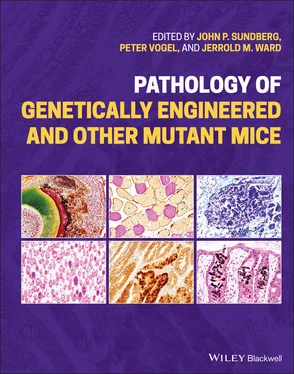Pathology of Genetically Engineered and Other Mutant Mice
Здесь есть возможность читать онлайн «Pathology of Genetically Engineered and Other Mutant Mice» — ознакомительный отрывок электронной книги совершенно бесплатно, а после прочтения отрывка купить полную версию. В некоторых случаях можно слушать аудио, скачать через торрент в формате fb2 и присутствует краткое содержание. Жанр: unrecognised, на английском языке. Описание произведения, (предисловие) а так же отзывы посетителей доступны на портале библиотеки ЛибКат.
- Название:Pathology of Genetically Engineered and Other Mutant Mice
- Автор:
- Жанр:
- Год:неизвестен
- ISBN:нет данных
- Рейтинг книги:3 / 5. Голосов: 1
-
Избранное:Добавить в избранное
- Отзывы:
-
Ваша оценка:
- 60
- 1
- 2
- 3
- 4
- 5
Pathology of Genetically Engineered and Other Mutant Mice: краткое содержание, описание и аннотация
Предлагаем к чтению аннотацию, описание, краткое содержание или предисловие (зависит от того, что написал сам автор книги «Pathology of Genetically Engineered and Other Mutant Mice»). Если вы не нашли необходимую информацию о книге — напишите в комментариях, мы постараемся отыскать её.
An updated and comprehensive reference to pathology in every organ system in genetically modified mice Pathology of Genetically Engineered and Other Mutant Mice
Pathology of Genetically Engineered and Other Mutant Mice
Pathology of Genetically Engineered and Other Mutant Mice — читать онлайн ознакомительный отрывок
Ниже представлен текст книги, разбитый по страницам. Система сохранения места последней прочитанной страницы, позволяет с удобством читать онлайн бесплатно книгу «Pathology of Genetically Engineered and Other Mutant Mice», без необходимости каждый раз заново искать на чём Вы остановились. Поставьте закладку, и сможете в любой момент перейти на страницу, на которой закончили чтение.
Интервал:
Закладка:
The high prevalence of skeletal and craniofacial malformations in ciliopathies [71] stems from the key role of HH signaling during the development of bone and the craniofacial complex. [72]. In both humans and mice, craniofacial malformations often manifest as micrognathia [73]. Any lines with newborn mice that show signs of impaired feeding or breathing should be carefully examined for the presence of ciliopathy‐related craniofacial malformations such as micrognathia and cleft palate. Dysfunctional HH signaling is also linked to the development of polydactyly in Bardet–Biedl, oral–facial–digital, Senior–Løken, and Meckel–Gruber syndromes, via the ciliary role in HH signaling [74]. In mice, polydactyly has been linked to mutations in IFT genes in mice [75], as primary cilia are required for cells to respond to SHH mediators [76]. Polydactyly is another ciliopathy‐related skeletal defect that should be identified in live mice or at time of necropsy.
To augment gross necropsy findings, whole‐mount skeletal staining is recommended to confirm and better characterize any suspected skeletal defects. Detailed protocols for whole‐mount skeletal staining of embryos which highlight cartilage using Alcian Blue and mineralized bone with Alizarin Red S are available [77].
Brain Malformations
Hydrocephalus is the most common CNS disorder caused by defective cilia, but ciliary involvement should be considered in any mice displaying brain malformations. Neurons and astrocytes have a single nonmotile primary cilium [78]. These cilia have critical roles in neurogenesis [79–81] and CNS development [82]. Normal CNS development is dependent on neuronal migration, which is a complex process involving signaling molecules that integrate intercellular signals with cytoskeletal proteins to initiate migration and nucleokinesis, which include neurotrophins, glutamate receptors, and peroxisome‐derived factors [83]. Dysfunctional primary cilia are responsible for many neurodevelopmental disorders [82], with the cerebellar malformations associated with Joubert syndrome (JBTS), Meckel–Gruber syndrome (MKS) and Bardet–Biedl syndrome (BBS) providing the most conspicuous examples [84]. Mice with a conditional deletion of 270049A03Rik (formerly Talpid3 ) in the CNS display the hallmark signs of JBTS, which include progressive ataxia, cerebellar hypoplasia, and abnormal decussation of the superior cerebellar peduncles [85].
Deafness
Deafness is associated with several ciliopathies, but the lesions in the inner ear are not detectable by light microscopy. Each sensory hair cell in the cochlea has a single transient nonmotile cilium (kinocilium) located at its apex. This so‐called kinocilium disappears by 12 days postpartum in mice and was long believed to be a transient embryonic organelle without any functional significance. However, kinocilia are required for correct polarization of sensory hair cells in the organ of Corti during development. The kinocilium initially occupies a central position on the sensory hair cell before migrating to the periphery where it is critical for the maturation and correct orientation of stereocilia [86]. There are several recessive mutations in CDC14 cell division cycle 14A ( Cdc14a ) that result in substantial perinatal lethality in mice, but the deafness and male infertility (abnormal morphology and motility of spermatozoa) phenotypes mirror those seen in humans with mutant CDC14A genotypes [87]. Despite the absence of light microscopic lesions in the cochlea in these cases, the deafness phenotype with concurrent defects affecting spermatozoa flagella would point toward a ciliopathy.
Anosmia
The primary cilia projecting from the surface of the olfactory epithelium utilize GPCRs on the ciliary membrane to detect and transduce signals from odorants [88]. The dysfunction or mislocalization of ciliary proteins and/or the loss of cilia will prevent olfaction [89], and mice lacking functional cilia on their olfactory neuroepithelium are anosmic [90]. Certain types of inherited anosmias may be accompanied by severely reduced ciliated borders over the olfactory neuroepithelium [91], but most defects involving the structure or signaling functions of olfactory receptors are not detectable by light microscopy or associated with degeneration or apoptosis of olfactory sensory neurons [89].
Obesity
Some ciliopathies in both humans and mice are associated with hyperphagia and obesity (e.g. Bardet–Biedl Syndrome, Alström Syndrome) [92]. Several mouse models recapitulate the human phenotypes and have proven useful in elucidating how sensory cilia influence appetite and the pathogenesis of obesity [93]. The sensory cilia on paraventricular nucleus neurons appear to control appetite by detecting signals from the arcuate nucleus. The tubby bipartite transcription factor ( Tub tub) mutant mouse, which develops progressive obesity and blindness, has defective trafficking of ciliary GPCRs in hypothalamic neurons [94]. Heterozygous mice hypomorphic for Rpgrip1l are leptin‐resistant, hyperphagic, and obese. The distribution and responses of leptin receptors in sensory cilia of hypothalamic neurons are abnormal in Rpgrip1l tm1Urtmice [95]. Similarly, obese and hyperphagic Ankrd26 Gt(XK525)Bygmice have defective primary cilia in the hypothalamic paraventricular nucleus [92]. Again, since there are many different underlying mechanisms that can contribute to the development of obesity, other cilia‐related phenotypes must be present to suspect a ciliopathy.
Genetic Background Effects
Cilia are incredibly complex organelles whose biogenesis and functions involve the interactions of many different genes (multigenicity). As a result, ciliopathies are phenotypically and genetically heterogeneous. Mutations involving a single gene can produce very different phenotypes depending on genetic background which introduces the varying effects of gene modifiers, gene redundancy, and allelism [15]. The modifier roles of specific alleles [96, 97] and multi‐protein modules further illustrate the complexity of interactions between ciliary proteins [98].
For example, in both human and mouse PKD, genetic background effects modulate the renal and extrarenal phenotypes [99, 100]. For example, Tmem67 bpckmice show a less severe kidney phenotype in a mixed background than they do in B6 or C3H/HeJ congenic lines [101]. The same mice on a B6 genetic background have a higher incidence of hydrocephalus, most likely due to underlying defects in ciliary structure/function [21]. Mouse strain‐dependent genetic background effects can influence the incidence of hydrocephalus in PCD mouse models. For example, Del ( 1)1Brk mutant mice on a B6 background usually die within the first week of life due to severe hydrocephalus, whereas mutants on a 129 background develop either mild or no hydrocephalus, indicating the presence of varying genetic modifiers in the different mouse strains [30].
Although mutations in a particular ciliopathy gene may present with a consistent phenotype, it is common for genetic modifiers to alter some of the clinical features observed within syndromes [102]. Clearly, some of the differences reported between mice and humans with mutations in syntenic genes are due to species‐specific differences in expression profiles, and/or the presence of compensatory proteins developed during divergent evolution of the species [57]. The extreme complexity of ciliary structures and functions undoubtedly accounts for most of the inter‐ and intra‐species variation in phenotypic expression. Physiological differences between these species may also greatly influence the phenotypic outcome.
Читать дальшеИнтервал:
Закладка:
Похожие книги на «Pathology of Genetically Engineered and Other Mutant Mice»
Представляем Вашему вниманию похожие книги на «Pathology of Genetically Engineered and Other Mutant Mice» списком для выбора. Мы отобрали схожую по названию и смыслу литературу в надежде предоставить читателям больше вариантов отыскать новые, интересные, ещё непрочитанные произведения.
Обсуждение, отзывы о книге «Pathology of Genetically Engineered and Other Mutant Mice» и просто собственные мнения читателей. Оставьте ваши комментарии, напишите, что Вы думаете о произведении, его смысле или главных героях. Укажите что конкретно понравилось, а что нет, и почему Вы так считаете.












